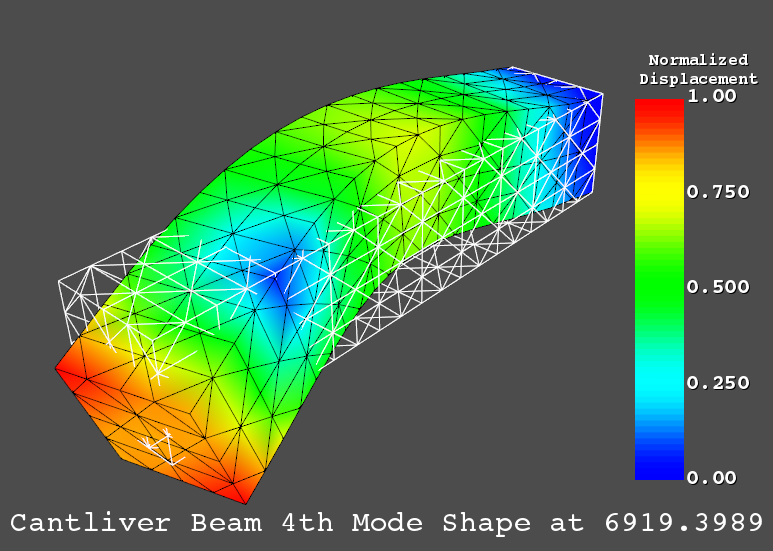处理 MAPDL Full 文件 (.full)#
MAPDL full 文件是一个 FORTRAN 格式的二进制文件,包含来自 Ansys 分析的质量和刚度。使用 Pyansys 可以将其作为稀疏矩阵或全矩阵加载到内存中。
Reading a Full File#
本例读入与上例相关的质量和刚度矩阵。 load_km 对自由度进行排序,节点从最小到最大排序,每个自由度(即 X、Y、Z)在每个节点内排序。
默认情况下,矩阵 k 和 m 是稀疏的,但如果没有安装 scipy ,或者使用了可选参数 as_sparse=False ,那么它们将是完整的 numpy 数组。
默认情况下, load_km 输出两个矩阵的上三角。可以通过访问 fobj.const 来识别分析的受约束节点,其中受约束的自由度为 True ,所有其他自由度为 False 。
这与 dof_ref 中的参照度相对应。
默认情况下,dof_ref 是不排序的。要对这些值进行排序,请设置 sort==True 。本例中启用排序是为了稍后绘制数值。
from ansys.mapdl import reader as pymapdl_reader
from ansys.mapdl.reader import examples
# 创建 result reader 对象并读入 full 文件
full = pymapdl_reader.read_binary(examples.fullfile)
dof_ref, k, m = full.load_km(sort=True)
ANSYS 只在 full 文件中存储上三角矩阵。要创建全矩阵,请执行以下操作:
k += sparse.triu(k, 1).T
m += sparse.triu(m, 1).T
如果安装了 scipy ,就可以求解系统的固有频率和模态振型。
import numpy as np
from scipy.sparse import linalg
# 对 k 矩阵进行调节,以避免出现 "因子完全奇异" 错误
k += sparse.diags(np.random.random(k.shape[0])/1E20, shape=k.shape)
# Solve
w, v = linalg.eigsh(k, k=20, M=m, sigma=10000)
# 系统自然频率
f = (np.real(w))**0.5/(2*np.pi)
print('前四阶固有频率')
for i in range(4):
print('{:.3f} Hz'.format(f[i]))
前四阶固有频率
1283.200 Hz
1283.200 Hz
5781.975 Hz
6919.399 Hz
绘制模态振型#
您还可以绘制该有限元模型的模态振型。由于受约束的自由度已从解法中移除,因此在显示位移时必须考虑这些自由度。
import pyvista as pv
# 获取 4 阶模态振型
full_mode_shape = v[:, 3] # 每个节点的 x、y、z 位移
# 重塑并计算归一化位移
disp = full_mode_shape.reshape((-1, 3))
n = (disp*disp).sum(1)**0.5
n /= n.max() # 将数组 n 中的每个元素都除以最大值,这样 n 中的所有元素都会在 0 到 1 之间,称之为 normalize 归一化。
# 加载归档文件并创建 vtk 非结构化网格
archive = pymapdl_reader.Archive(examples.hexarchivefile)
grid = archive.parse_vtk()
# 绘制归一化位移图
# grid.plot(scalars=n)
# 绘制位移曲线
pl = pv.Plotter()
# add the nominal mesh
pl.add_mesh(grid, style='wireframe')
# copy the mesh and displace it
new_grid = grid.copy()
new_grid.points += disp/80
pl.add_mesh(new_grid, scalars=n, stitle='Normalized\nDisplacement',
flipscalars=True)
pl.add_text('Cantliver Beam 4th Mode Shape at {:.4f}'.format(f[3]),
fontsize=30)
pl.plot()

此示例内置于 pyansys-mapdl ,可通过 examples.solve_km() 运行。
FullFile 对象方法#
- class ansys.mapdl.reader.full.FullFile(filename: str | Path)#
Stores the results of an ANSYS full file.
- Parameters:
filename (str) – Filename of the full file to read.
Examples
>>> from ansys.mapdl import reader as pymapdl_reader >>> full = pymapdl_reader.read_binary('file.rst') >>> print(full) PyMAPDL-Reader : MAPDL Full File Title : Demo Version : 20.1 Platform : WINDOWS x64 Jobname : file Matrices : 2 Equations : 345 Nodes : 115 Degrees of Freedom : 3
- property const#
Constrained DOF Returns the node number and DOF constrained in ANSYS.
Examples
>>> full.const array([], shape=(0, 2), dtype=int32)
- property dof_ref#
Sorted degree of freedom reference.
Examples
>>> full.dof_ref array([[ 1, 0], [ 1, 1], [ 1, 2], [115, 0], [115, 1], [115, 2]], dtype=int32)
Notes
Obtain the unsorted degree of freedom reference with >>> dof_ref, k, m = sparse_full.load_km(sort=False)
- property filename#
String form of the filename. This property is read-only.
- property k#
Stiffness Matrix corresponding to sorted DOF.
Examples
>>> from ansys.mapdl import reader as pymapdl_reader >>> full = pymapdl_reader.read_binary('file.rst') >>> print(full.k) <345x345 sparse matrix of type '<class 'numpy.float64'>' with 7002 stored elements in Compressed Sparse Column format>
- load_km(as_sparse=True, sort=False)#
Load and construct mass and stiffness matrices from an ANSYS full file.
- Parameters:
as_sparse (bool, optional) – Outputs the mass and stiffness matrices as scipy csc sparse arrays when True by default.
sort (bool, optional) – Rearranges the k and m matrices such that the rows correspond to to the sorted rows and columns in dor_ref. Also sorts dor_ref.
- Returns:
dof_ref ((n x 2) np.int32 array) – This array contains the node and degree corresponding to each row and column in the mass and stiffness matrices. In a 3 DOF analysis the dof integers will correspond to: 0 - x 1 - y 2 - z Sort these values by node number and DOF by enabling the sort parameter.
k ((n x n) np.float_ or scipy.csc array) – Stiffness array
m ((n x n) np.float_ or scipy.csc array) – Mass array
Examples
>>> dof_ref, k, m = full.load_km() >>> print(k) (0, 0) 163408119.6581276 (0, 1) 0.0423270 (1, 1) 163408119.6581276 : : (342, 344) 6590544.8717949 (343, 344) -6590544.8717950 (344, 344) 20426014.9572689
Notes
Constrained entries are removed from the mass and stiffness matrices.
Constrained DOF can be accessed from
const, which returns the node number and DOF constrained in ANSYS.
- property load_vector#
The load vector
Examples
>>> full.load_vector array([0., 0., 0., ..., 0., 0., 0.])
- property m#
Mass Matrix corresponding to sorted DOF.
Examples
>>> full.m <345x345 sparse matrix of type '<class 'numpy.float64'>' with 2883 stored elements in Compressed Sparse Column format>
- property neqn#
Number of equations
Examples
>>> full.neqn 963
- property pathlib_filename#
Return the
pathlib.Pathversion of the filename. This property can not be set.